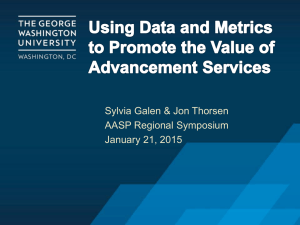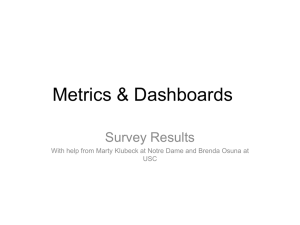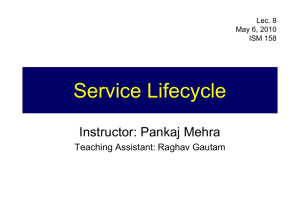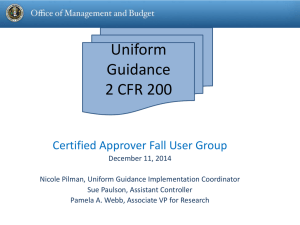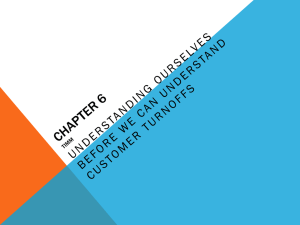Do It Yourself Metrics
advertisement
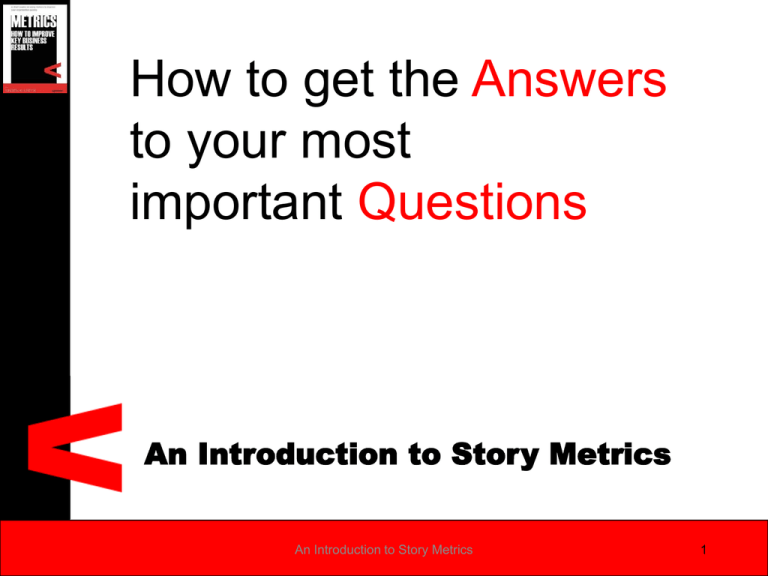
How to get the Answers to your most important Questions An Introduction to Story Metrics An Introduction to Story Metrics 1 Martin Klubeck Strategy & Planning Consultant Office of Information Technologies University of Notre Dame 574-631-5447 mklubeck@nd.edu An Introduction to Story Metrics 2 An Introduction to Story Metrics 3 Agenda • Metrics Overview • Demonstrate the Process • Hands-on An Introduction to Story Metrics 4 What Is A Metric? A Common Language • Data • Measure • Information An Introduction to Story Metrics 5 Branches Leaves Measures Limbs Information Data Trunk Metric Roots The Question An Introduction to Story Metrics 6 A Complete Story An Introduction to Story Metrics 7 Anthologies May Be Better An Introduction to Story Metrics 8 Metrics… • Are question driven • Tell a complete story • Include: • • • • Data Measures Information Other Metrics An Introduction to Story Metrics 9 Help Desk Example Data Measures Number of trouble calls Number of opened cases Number of closed cases Number of employees Number of survey responses Number of calls per hour Number or cases closed by worker Information Number of calls for each hour compared to number of workers on shift. Average length of time to close a case, grouped by type Average customer satisfaction rating An Introduction to Story Metrics 10 Help Desk Example Average number of open cases from 1999-2002 225 manning 12 200 11 175 10 150 9 125 8 100 Min manning 50 7 6 25 METRIC Max manning 5 0 0 Explanation: The manning over the academic year was not in line with the number of trouble calls received – based on data collected over the last three years. Result: We’ve re-aligned our manning for the coming year to match the level of need each month. An Introduction to Story Metrics open cases manning 11 Why Use Metrics? To Help You … • • • • Gain support from above Provide visibility Improve Make better “data informed” decisions An Introduction to Story Metrics 12 How Not To Use Metrics To “support my case*” To “motivate” the staff To “manage” the staff or others To evaluate individual performance An Introduction to Story Metrics 13 How To Use Metrics • Explain how they will and WON’T be used • Investigate • Share – Close the loop An Introduction to Story Metrics 14 Who Will Use The Metric? • Customer Community • Management • Owners and Workers • Leadership An Introduction to Story Metrics 15 Top Five Warning Signs that this training has failed 1. The boss says – “I’ll know it when I see it.” 2. “We’ve been collecting this data for five years and no one is using it.” 3. “Do we have any data on...?” 4. “They don’t trust the data.” 5. “Sounds interesting, let’s collect it.” An Introduction to Story Metrics 16 What Is The Root Question? The 5 Whys An Introduction to Story Metrics 17 Drawing A Picture • Focus on “how it looks” • A picture is worth a thousand words • Send a clear message An Introduction to Story Metrics 18 An Introduction to Story Metrics 19 An Introduction to Story Metrics 20 An Introduction to Story Metrics 21 An Introduction to Story Metrics 22 An Introduction to Story Metrics 23 Metrics Tools • Implementation Guide – adds rigor and structure • Answer Key – “cheat sheet” for developing metrics • Process Documentation – How to An Introduction to Story Metrics 24 The Complete Metric “Pallet” • • • • • • • • • • • • • Metric Name Purpose Metric Area/Category Customer Graphical Representation Explanation Metrics Analysis Measures used to Develop Metric Collection Schema Schedule Assumptions and Constraints Related Metrics and Data Dependencies Lessons Learned An Introduction to Story Metrics 25 The Primary Metric Colors • Purpose • Graphical Representation • Explanation • Metrics Analysis • Measures used to develop Metric An Introduction to Story Metrics 26 Delivery Effectiveness Information Needs Customer view Value to Organization Customer Satisfaction Customer Service Cost Efficiency Business view Time Quality Employee Satisfaction Training Human Resources Work Environment Worker view Reward & Recognition Management of Resources Project/program Status Resource Allocation Visibility Management view Strat. Planning & Goal Attainment Communications Priority Setting An Introduction to Story Metrics 27 Hands-On Session An Introduction to Story Metrics 28 Designing your first metric 1. What is your root question? 2. Visualize the Answer 3. Identify the Measures 4. Find the data An Introduction to Story Metrics 29 Summary Embrace the Opportunity Start with the Question Draw the Picture Tell a Complete Story Repeat - Tweak - Delete An Introduction to Story Metrics 30 Q&A An Introduction to Story Metrics 31 Martin Klubeck Strategy & Planning Consultant, Office of Information Technologies, University of Notre Dame 574-631-5447 Klubeck.1@nd.edu An Introduction to Story Metrics 32 Effectiveness Ratio of Promoters to detractors Reponse to Customer Satisfaction Survey Grad/Professional (718) 0.3 Fifth year (40) 0.1 Fourth year (660) 0.1 Third year (592) 0.1 Second year (787) 0.1 First year (772) 0.1 Students (3574) 0.1 1.1 Faculty & Staff (1280) -1.0 -0.5 0.0 0.5 1.0 1.5 2.0 The higher the ratio the better - a ratio of 1 (promoter = detractor) is the threshold Signif icant securit y incident s Core/Critical service availability (file / storage, enterprise applications, email, and netw ork services) Target is >= 99.90% 99.92% 2003 99.90% 99.90% 99.90% 99.89% 99.88% 2004 99.86% 99.84% 99.82% 2005 99.81% 99.80% 0 99.78% 99.76% 2 4 6 8 10 Threshold = 2, Target is less t han 2 2005 2004 2003 2002 An Introduction to Story Metrics 33 Efficiency Client-Staffing Ratio Time To Resolve 6 45,000 70.0 4.9 5 4.9 38,504 4.5 37,260 35,000 30,782 34,268 30,000 3 3.3 3.1 2.9 61.8 59.5 217 60.0 52.9 4 250 66.6 40,000 200 192 183 50.0 166 25,000 2.8 20,000 2.2 2 15,000 150 40.0 30.0 100 10,000 1 5,000 in days 0 2004 2003 17.8 15.9 15.4 14.1 50 0 2005 20.0 10.0 2002 5.5 6.2 6.3 7.0 2005 2004 2003 2002 0.0 Overall average time to resolve Target = <= 5 days Average time to resolve - Help Desk Target = <= 2.75 days 0 Number of overall cases Students to OIT employees OIT Spending $9,000 Faculty to OIT employees Staff to OIT employees Centralized OIT Expenditures (in Millions) 25% 23% $8,000 21% 20% $7,803 $6,928 $7,000 $700.0 $6,813 $6,473 $800.0 15% $6,000 $5,000 10% $4,000 5% 4.80% $668.7 $626.3 4.70% $600.0 4.70% $589.2 4.60% $500.0 4.50% $400.0 $3,000 $2,884 $2,351 $2,000 2% 1% $2,498 0% $2,476 0% 4.40% $300.0 $200.0 $100.0 4.30% $20.8 $7.7 4.30% $19.6 $10.0 $21.1 2004 2003 $5.8 $0.0 -6% $1,000 -5% 4.60% 4.20% 4.10% 2005 -7% $0 -10% 2005 Per student 2004 Per faculty and staff 2003 Per Student Change 2002 Actual ND Expenditures (Millions) Actual OIT Expenditures (Millions) Renovare (ERP) expenditures (Millions) OIT & Renovare (ERP) Expenditures / University Expenditures Per faculty and staff change An Introduction to Story Metrics 34

